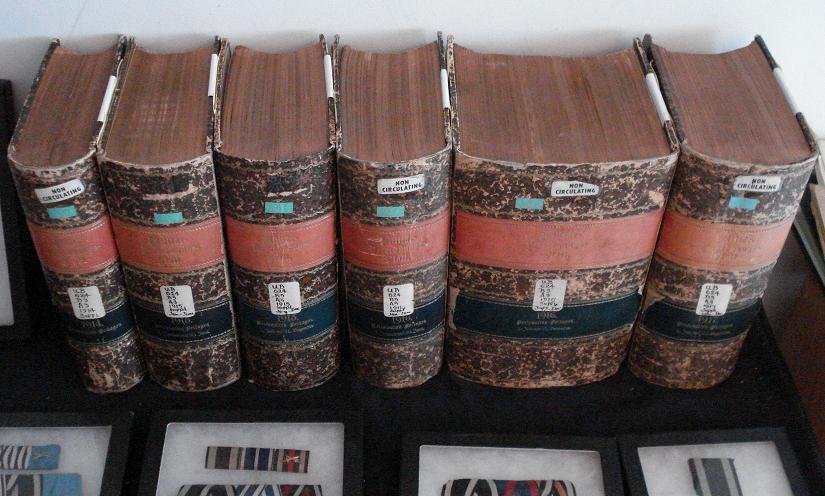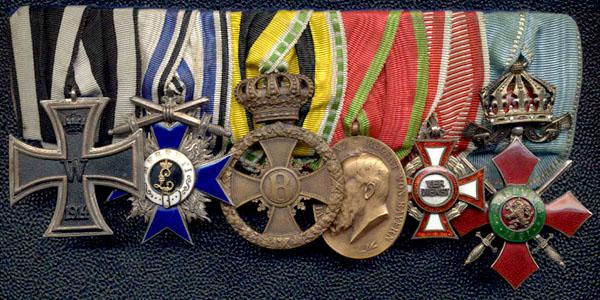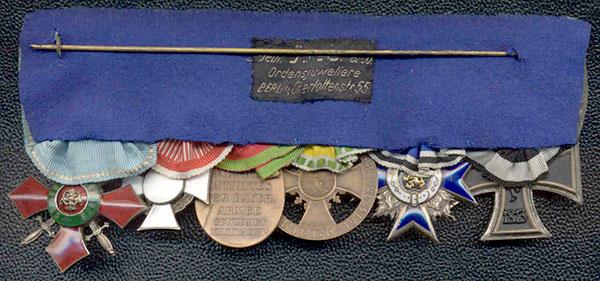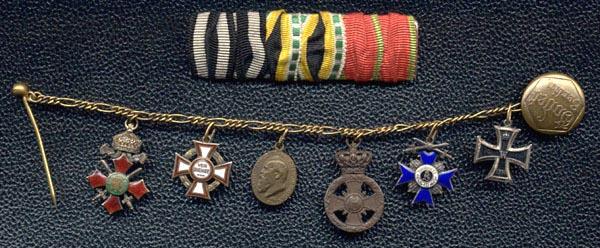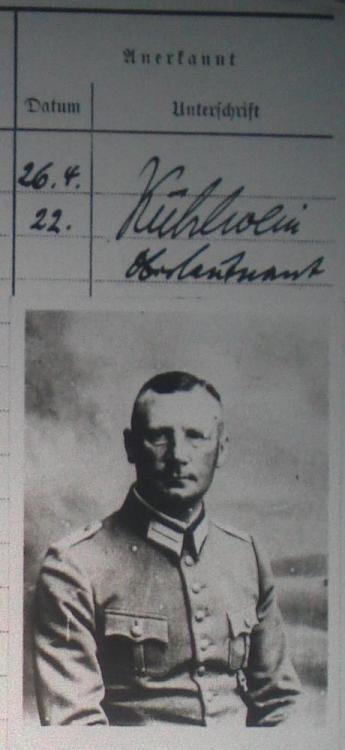-
Posts
4,908 -
Joined
-
Last visited
-
Days Won
97
Content Type
Profiles
Forums
Blogs
Gallery
Events
Store
Everything posted by Dave Danner
-
David, There are no rolls for the KVK, and from what I saw in the archives in Wolfenbüttel, only about a quarter of the award files with recommendations and approvals remain. Christophe Thanks for your observations. The volume and page are there because that is the way the roll was organized. Also, it is possible someone may want to see the actual award recommendation, if it still exists, so they would need that information to draw the right document at the archives. Additionally, many award dates are unknown, as the recommendations and Resolutions-Vorschläge are missing; the volume and page can usually narrow down the award date within a month or so. Here is an example of the roll, BTW. It does have the advantage over many Imperial-era rolls of being legible.
-
Even in peacetime the MWB often failed to report all non-Prussian awards to Prussian officers. This was often the case for Reserve and Landwehr officers who received their awards in their peacetime capacity. During the war, the reporting of foreign awards stopped almost entirely and the reporting of other German state awards was limited to Bavaria, Saxony and Württemberg and even this fell off after a while. Bavaria and Württemberg continued to report awards through most of the war, and those lists have been published, but even these are missing many awards which were not gazetted in the Bavarian and Württemberg equivalents of the MWB. Saxony, like Prussia, stopped including foreign awards fairly quickly. The reason why Bavaria stopped publishing all awards should be obvious from the picture below. These are the 1914, 1915/1, 1915/2, 1916/1, 1916/2 and 1917/1 volumes of the Verordnungsblatt des Königlich bayerischen Kriegsministeriums. The sheer number of Iron Cross awards, as well as the newer König-Ludwig-Kreuz for non-combat merit, made the second half of 1916 more than twice the length of the first half.
-
I can't say for certain. It might be a substitute for the EK2, although he might have worn an EK1 and left an EK2 off the chain. He is not in the 1918 Handbuch für das deutsche Reich, so he was not apparently in diplomatic service when that was published. If he got a Kronenorden it might have been late in 1918 and I don't have any sources for that. I have been slowly going through the Reichsverwaltungsblatt issues in 1918 looking for awards made to government officials after the 1918 Prussian Court and State and 1918 Reich Handbuch were published, but it an incomplete list and a slow process.
-
Friedrich Graf v. Plettenberg-Heeren still had the RAO4 and KO4 in the 1918 Handbuch über den preußischen Hof und Staat. I can't see a bump all the way to an RAO2 and KO2 in the time left. Also, Portugal was also an enemy state, so if he removed the Italian order for that reason, it would make sense that he would remove the Portuguese as well. That said, he is a close match otherwise. He received the Lippe-Detmold Kriegsverdienstkreuz on 29 January 1918 as a Major der Reserve a.D. and Adjutant to the commander of the Oberkommando in den Marken. In his receipt for the cross dated 2. February 1918, he listed the following decorations: RAO4, KO4, EK2, JohR, LD1, BayKLK, BrH2b, WF3a, BMO3, JK5, PC3. Later in 1918, he also received the Austro-Hungarian Militärverdienstkreuz 3. Klasse mit der Kriegsdekoration 3. Klasse. The Johanniterorden and the Bulgarian and Braunschweig orders were neck decorations. So this bar is close on the wartime decorations with the EK2 and the Bavarian and Lippe awards, but differs on the Austrian and Hamburg awards. And it is close on the peacetime awards with the LD1, WF3a and PC3, but differs on the lack of the two Prussian orders and on the Italian order. So I would say close, but no cigar at this point. Edit to add: I have only managed to get through about 40% of the LK receipts in Detmold, and don't have a match yet. The receipts usually include other awards, so I believe a match will be found eventually.
-
He is actually in the 1914 rank list, on page 755, as a Rittmeister der Reserve (V Berlin) in the reserve of Husaren-Regiment Nr. 7, with the RAO4, LD1, CDIII2 and JM4. It is Dr. Arthur Mudra, Ambassador to Ecuador from 1928 to 1932. He was born on 30 December 1871 in Berlin and died in 1960. Almost all of his foreign decorations were as a diplomat, not an Army officer. He was a consul in Shanghai during the Boxer Rebellion, and later in Yokohama and Nagasaki (where he also represented Italy and Romania), so that would account for the Chinese, Japanese and Italian decorations. In 1910 he was Generalkonsul in Philadelphia and was still there after World War I started, since he is recorded as protesting British armed merchant ships in the Port of Philadelphia in September 1914. He returned to Germany at some point later, and received the Schaumburg-Lippe Kreuz für Treue Dienste on 25.02.1916 while serving with Staffelstab 389. I would assume there is a more complete biography in the Biographisches Handbuch des deutschen Auswärtigen Dienstes 1871-1945, but I do not have the volume with the letter "M". Maybe Glenn or Daniel has access to it.
-
Fritz Kraus, born 27.2.1882 in Homburg vor der Höhe, was the commander of III./Landwehr-Infanterie-Regiment Nr. 118. He was promoted to Leutnant der Reserve on 19.12.1907, Oberleutnant der Reserve on 22.3.1915 and Hauptmann der Reserve on 20.2.1918. He was in LIR 118 when he was promoted to Oberleutnant in March 1915, so he apparently spent most of the war in that regiment. I don't know if that regiment had a regimental history. Kraus was a Reichsbank-Beamter in Oldenburg according to the 1911 rank list for reserve officers and the 1917 address book for Oldenburg. He was apparently not senior enough in the Reichsbank to have an entry in the 1918 Handbuch für das Deutsche Reich. Given his regimental affiliation, he would doubtless have received the Hesse Allgemeines Ehrenzeichen "Für Tapferkeit". The Oldenburg connection might have gotten him a Friedrich-August-Kreuz. Unfortunately, both of these are awards for which no rolls exist.
-
For some reason, the rank lists that include this medal fail to distinguish between the two. Bavarian rank lists do, but they use icons (a J in a circle for the Jubiläumsmedaille and a PL in a circle for the Prinzregent Luitpold-Medaille). However, I have noticed that the Bavarian Kriegsranglisten and Kriesstammrollen on Ancestry often use "PRLM" when it should be the Jubilee Medal.
-
Gerhard Martin Jordan (1871-1945). From 1909 to 1945, he was the Domänenpächter of the Fürstlich Schwarzburgischen Domäne Griesheim. He was a Hauptmann der Landwehr-Feldartillerie 1. Aufgebot, and was given the Charakter of Major der Landwehr a.D. when he was retired on 9 December 1919. He received the Fürstlich Schwarzburgisches Ehrenkreuz on 9 December 1914 as commander of the 5. Artillerie-Munitions-Kolonne of the XI. Armeekorps. He received the k.u.k. Österreich-Ungarisches Militärverdienstkreuz 3. Klasse mit der Kriegsdekoration 3. Klasse while serving with Staffelstab 135. He also had the Landwehr-Dienstauszeichnung 1. Klasse. https://de.wikipedia.org/wiki/Schloss_Griesheim https://de.wikipedia.org/wiki/Griesheim_(Stadtilm)
-
The Roeßler who was a reserve officer in DR 13 had transitioned to the Landwehr by 1914. He is in the 1914 rank list as an Oberleutnant der Landwehr-Kavallerie 2. Aufgebot in Landwehrbezirk V Berlin. He was promoted to Rittmeister der Landwehr on 24.12.1914, and was serving at the time with the Munitions-Kolonnen und Trains of the III. Reserve-Korps.
-
The family originated in the western Harz region, around Osterode and Goslar, so closer to Hannover and Braunschweig than Anhalt. Karl was the son of Wilhelm v. Reck (1834-1901), a Bavarian Gendarmerie-Oberstleutnant. Wilhelm was the son of Karl (1801-1868), a Bavarian Oberst. Karl was the son of Johann Jakob Christian (1755-1813), a Bavarian Oberapellengerichts-Registrator. JJC was the son of Johann Gustav (1703-1786), a British and Braunschweig-Lüneburg Legationsrat in Regensburg. Johann Gustav was the son of Johann (1662-1736), a Hannoverian Gesandter in Regensburg. This was the connection between Hannover/Braunschweig and Bavaria. The Bavarian branch was also the source of the baronial line of Freiherrn v. Reck in Baden. A separate Hannoverian line remained around Hannover, Hameln and later Alfeld an der Leine. No other Reck from any of these branches received the Friedrichkreuz, so it was not a family connection there. According to the Anhalt Court and State Handbook, Reck received the AB3a in 1906. According to the Bavarian Kriegsministerium's Verordnungsblatt, it was approved by the Prinzregent on 11.11.1906. Reck's RAO4 was approved on 14.12.1906. I would guess that Reck got the RAO4 and AB3a in 1906 as an ILR officer in Munich who probably was assigned to some sort of protocol duties. These duties often put an officer in a position to pick up various courtesy awards when dealing with visiting dignitaries. He was then nominated for the Friedrichkreuz during the war simply because he was already a recipient of the AB3a and not because of any additional wartime connection (there was only one other 20.bay.IR recipient of the Friedrichkreuz, a Hoboist-Sergeant).
-
I assume you are referring to the cross after the Iron Cross? It is the Prussian Verdienstkreuz für Kriegshilfe, which basically replaced the Iron Cross on the white/black ribbon for merit on the homefront. As a Prussian war decoration, it ranked ahead of peacetime decorations, even orders of knighthood, so it is in its proper place.
-
-
It is Kühl, with the Umlaut. From 1938 to 16.07.1940, he was on the General Staff of the 4. Infanterie-Division. From 21.09.1940 with effect from 25.09.1940 to 01.09.1943 he was Oberquartiermeister of XXI.Armeekorps. From 17.12.1943 to 31.8.1944, he commanded Grenadier-Regiment 145. On 26.10.1944, he was tasked with the temporary leadership (m.d.stv.F.b.) of the 365.Infanterie-Division, on 10.12.1944 tasked with the leadership (md.F.b.) of the division, and finally on 01.03.1945 with his promotion to Generalmajor named commander of the division. Besides the Deutsches Kreuz in Silber, he was also named in the Ehrenblatt des deutschen Heeres on 20.07.1944. Here is an earlier example of his signature. It changed a little bit over 20 + years.
-
The correspondence between the officials in Greiz and Kagohl 4 was in the archives in Greiz. There is no roll, just a lot of correspondence on award recommendations and some receipts indicating awards made. The vast majority of awards of the Ehrenkreuz and -Medaille were made in Gera by Reuß j.L., since Reuß j.L. was twice the size of Reuß ä.L. and recommendations to anyone connected with IR 96 or its Tochterformationen went to Gera, where IR 96 was based. Unfortunately, most records in Gera were destroyed, and the rolls apparently lost. Gunnar, the correspondence was between 5.3.1917 and 23.6.1917. Nothing there about where he was in 1916 and the only award dates were for the Iron Cross. I assume you have his career path up to March 1916 from the Bavarian AFP 6 Kriegsrangliste?



.thumb.jpg.a18aa63d550841b0953896e198d0a36f.jpg)
